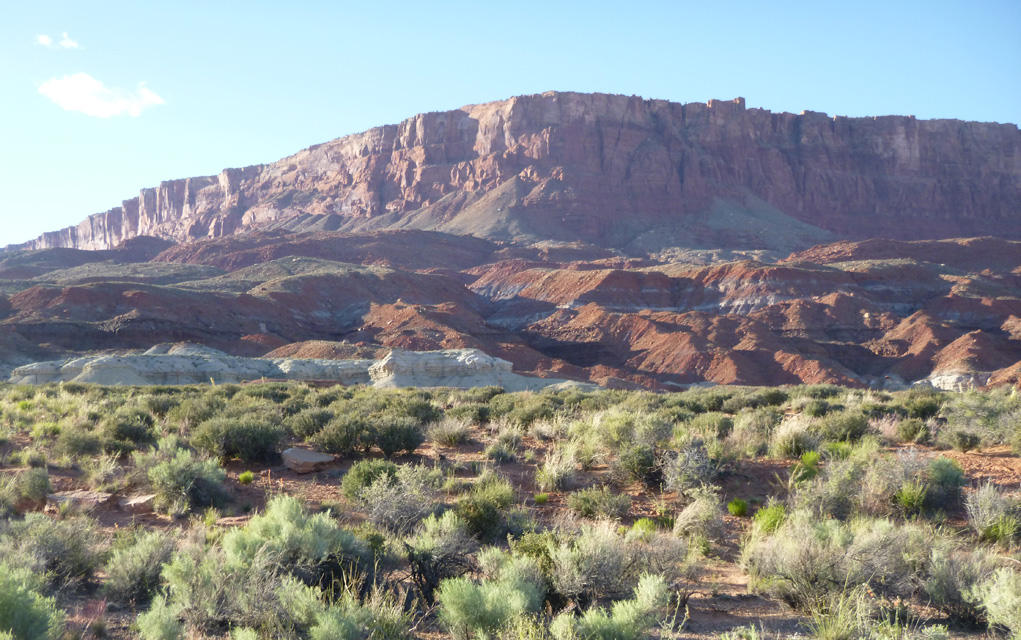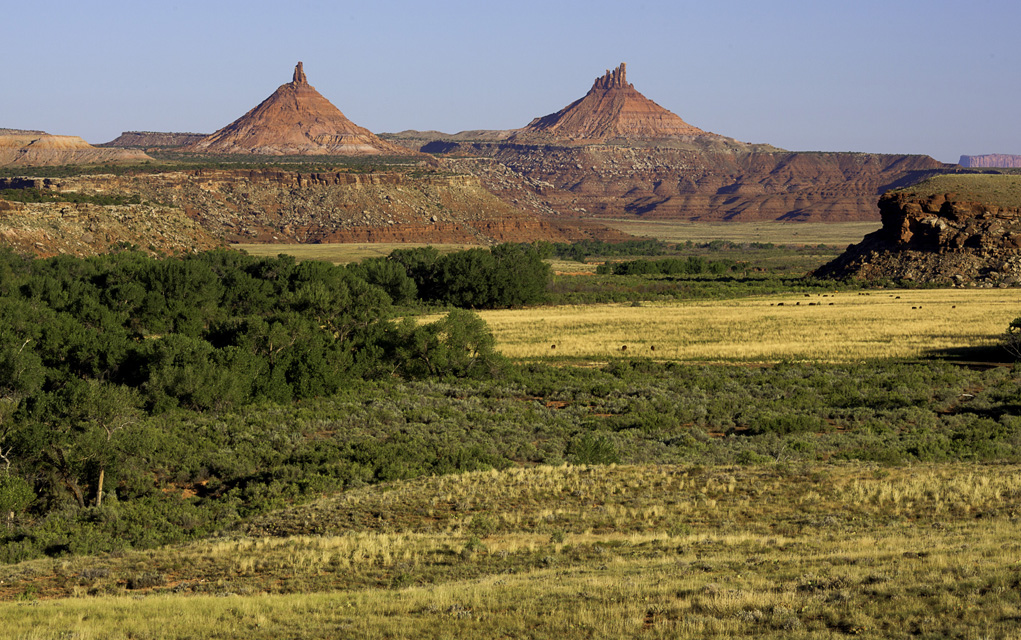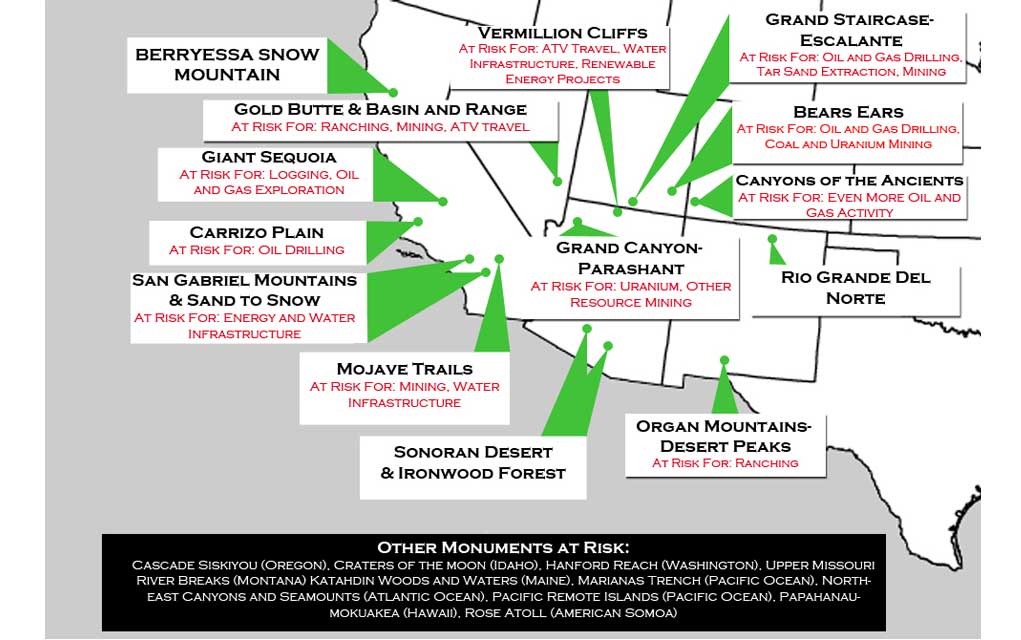
We started in the land of doggie spas and building contractors — Orange County, California. In an hour we’d be underwater, and then on Mars after that. Then a Subway sandwich shop outside Las Vegas. But there was no better place to begin. No other, either. On a trip to the great unknown the national monuments provide, the excess of the OC, with its toll roads, foot-wide side-yards, and drought-proof golf courses, was a contrasting case study in how mankind can full-nelson nature until it does what it wants.
My wife and I had long talked about how neat it’d be to show our kids all the national parks and monuments, taking road trips to one or two every summer. We figured it’d make for cheap vacations while exposing our kids to the joys of nature and the value of conserving it. It was a well-contrived idea, except that in our rosy visions of Tomorrowland, we didn’t account for Donald Trump.
So when the president issued an executive order in April to review the statuses of 27 national monuments, our timeline accelerated. The humbling effect the desert would have on our kids would surely be lessened if the saguaros were coated in tar balls. Future kids be damned, we’d have to take our 10-month-old to as many national monuments between California and Colorado as possible while they were still there.
The term “national monuments” is a little misleading it turns out. Rather than buildings or statues, they are areas designated by the president for their natural, scientific or cultural significance, which can vary in size from a couple dozen to millions of acres. Theodore Roosevelt signed the Antiquities Act in 1906, granting the president the ability to create such national monuments after lawmakers in the West reported looting and vandalism of Native American artifacts from public lands.
It wasn’t long before the Antiquities Act attracted controversy, however. When miners wanted to excavate the Grand Canyon, Roosevelt named it a national monument, which effectively blocked the extraction of minerals in the area. The Grand Canyon later achieved National Park status, but the precedent had been set for presidents to effectively preserve broad swathes of land from special interests with the stroke of a pen via the Antiquities Act.
Those same special interests — this time after oil and gas, coal, uranium and other resources — have continued to cry foul over the years. Most recently, they, and their political advocates, claim national monuments signed by Presidents Bill Clinton and Barack Obama, amounted to “federal land grabs,” which were done with little input from the public just before the end of their respective terms. (It’s rarely mentioned, by the way, that George W. Bush signed in four national monuments at the end of his term, and Ronald Reagan signed in two.) There are 127 national monuments in total, with more than half designated by Roosevelt, Clinton, Bush and Obama.
Some observers believe that the review of the national monuments ordered by Trump really focuses on Bears Ears, a 1.35-million-acre expanse of land that contains significant historical importance — human presence in the region dates back 13,000 years. It’s also almost entirely atop oil and gas, coal and uranium reserves.
Secretary of the Interior Ryan Zinke recently recommended that Bears Ears be minimized. Such a move has no precedent, and so it’s not clear what could happen to the other national monuments — and parks — that protect vital natural and cultural resources, but also sit atop energy deposits.
In this context, with Trump’s 60-day review set to end on June 25, the goal of visiting eight Western national monuments became less about sightseeing and more about determining value: What value do these places hold to those who want to mine, drill and otherwise trample them; and what is the value to the public of keeping them as they are?
Leaving Orange County, we headed east on a toll road through the mountains and into the Coachella Valley. At Whitewater, we exited the interstate and traveled along a river basin. Due to an unusually wet winter, the basin was an oasis. Dusty white river banks sloped down into a jungle of palm trees and wildflowers. Wheezing flycatchers perched atop the low canopy and looked into the vast chirp below for prey. Wrapping around the corner, the peak of San Gorgonio, snowcapped and framed by canyon walls, made obvious the monument’s name: Sand to Snow.

Sand to Snow was designated as a national monument because it serves as a vital wildlife corridor for animals traveling between the San Gabriel Mountains to the west and Mojave Desert to the east. On either side of the monument is the region’s tallest peak, San Gorgonio, and the region’s lowest point, the Salton Sea.
There are few valuable natural resources under Sand to Snow, but the space is still coveted: The Los Angeles Department of Water and Power tried unsuccessfully to build power infrastructure through the area 10 years ago. Removal of a national monument designation would allow for such development.
Backing out of the monument, dramatic views of the mountain range set against the sandy basin floor eventually gave way to dozens of wind turbines, perched eerily over the road like pinwheels placed by our invisible giant overlord’s invisible giant daughter — even renewable energy can heavy-hand nature. Then, the open road and signs for Dairy Queen and Burger King.
Like the ground filters sediment and bacteria from groundwater, the Joshua trees seems to filter out human culture. Through Twentynine Palms and Old Dale, slowly the signs of American life — the bail bond shops and the Dollar Generals — thinned out. Before long, the road turned gray-white, and slinked to one lane, and then cars stopped passing. Turning north to Amboy, we entered Mojave Trails National Monument, but not before passing, not 100 yards before the monument’s entrance, a doublewide Trump-Pence sign, which was a reminder that the people who live near these remote monuments may not always like them.
At some point, the mountains in the distance, jutting out of velvet expanses of sand into purple-noon skies, just seemed too weird to not stand and marvel at. It was silent outside. So silent it sounded like we’d dunked our heads underwater. We thought we might be when a man wearing a wetsuit to protect himself from the sun came running by later with an American flag strapped to his back. It was odd. There was no wind, no distant cars. We held our breaths because they were obstructing perfect silence. Then, a scuttle in the dust — some desert bug. This was the nothingness we came for. Then our son babbled nonsense.

But the mystery of Mojave Trails only begins with its deep quietude and Martian mountains. Ancient lava flows once scored the area, leading eventually to pumice mining. We drove by a miles-long skillet of cracked white dirt, which ended up being a calcium chloride mine. Mojave Trails is named, in part, for the old Native American trading routes that once traced the land, but now the only major traffic it gets is the few drivers trying to get to Route 66, truckers going to and fro said mineral mines and a natural gas pipeline.
Underneath, however, is an aquifer that Cadiz, Inc., wants to pull from and pump to Southern Californians. Sen. Dianne Feinstein called it “a grave threat to the California desert,” adding that the project would extract five times more water than the aquifer can replenish naturally. In March, the Bureau of Land Management (BLM), under Trump, abolished two legal obstacles for Cadiz’s project, and Trump nominated a Cadiz business partner to a position in the Interior. Removing national monument status would eliminate almost all roadblocks for the water project.
We passed through another Joshua tree desert before hitting the interstate and then Las Vegas. We drove down the Strip to see the humanity. Coming from the desert, it was only slightly schlockier than usual, but everyone was in on the joke anyway.
Leaving the fake monuments in Vegas, the earth started to redden and plateaus popped up on the horizon. To the north of Lake Powell sits Gold Butte, named for its… gold and buttes. A clay-thickened river bisected the brown, chunky buttes, and the road swung up and down, with potholes and debris making driving perilous. This monument, at the southern tip of Nevada, is relatively undeveloped, but it also hasn’t avoided controversy.
In 2014, supporters of Cliven Bundy, some armed, faced off with BLM officials and law enforcement after a 20-year battle between Bundy and BLM over grazing rights. Bundy refused to pay to lease the public land for grazing, and when — two decades later — the BLM had finally had enough, they seized his trespassing cattle and arrested him.
Driving through the northern end of Gold Butte, signs supporting Bundy’s cause hung undisturbed, and the cattle allegedly still graze.

Indeed, the greatest threat to Gold Butte is from those who tread on it: ATVs, which can stifle the growth of vital vegetation and disturb animal movement, and ranching. But at the end of the rough and tumble road through Gold Butte, we found the shabby entrance to the Parashant, whose land on the northern rim of the Grand Canyon has been pegged for solar energy expansion and sits atop a trove of valuable minerals.
The Parashant is rugged, and it was immediately clear the 2011 Hyundai Sonata was not built to explore it. But while we traveled its northwestern mountain passes on the way to better roads, the vast wilderness of the Parashant in the distance played host to a bevy of endangered species from the California condor to the desert bighorn sheep. Their biggest threat isn’t our travel, but the 466,384 tons of uranium oxide underneath.
Not only would the expansion of uranium mining disturb the wildlife and Native American artifacts on the land, but it also poses a threat to the region’s water supply. The same wet winter that buoyed the oasis in Sand to Snow flooded at least one uranium mine in the monument, threatening to contaminate the region’s waterways. To counteract this, officials sprayed the water from the mine into the air to let it evaporate.
Back on the road eastward to Vermillion Cliffs, the ground turned cherry red. We passed through Colorado City, the home of an FLDS community, and a pottery store where it was guaranteed on a big, wooden sign that the wares for sale were “NOT MADE IN CHINA.” This was all-American.
We ascended into a 7,000-foot-elevation forest, with stick trees that rounded the wind like cilia into a hum. Here, says the Arizona Wildlife Coalition, water development has already “altered or destroyed” the ecosystem, but when we stopped in at the Cliffdweller’s Lodge, there were plenty of trout fisherman amping up for a morning in the Colorado River and the iconic Horseshoe Bend.

To cross the Colorado in the morning, we drove over a manmade, sturdy bridge, which was erected next to the Navajo Bridge, decommissioned in the ’90s when traffic got too great to carry the load. The bridges stand just south of Lake Powell, a manmade dam, which loses 860,000 acre-feet of water every year due to evaporation, according to the Glen Canyon Institute, constituting a bane to the efforts of water conservationists who think one manmade reservoir — Lake Mead, above Las Vegas — already threatens the viability of the Colorado River. Utah’s congressional delegation recently asked Trump to expedite the construction of a water pipeline from Lake Powell, but environmentalists say there’s not enough water in the lake to make it viable.
It was then, halfway through, that the moral of the trip became evident: Man has severely messed up parts of our greatest natural and cultural resources, but the promise of exploring and preserving the rest is righteous. The remaining monuments were proof positive of the theory, including the monuments of the greatest current controversies: Grand Staircase-Escalante and Bears Ears in Utah.
Nestled between national parks, Grand Staircase is an outdoor playground that attracts thousands of recreationists every year. But it’s coveted by the energy industry as well, as there is about $330 billion of untapped coal, oil and gas, and minerals under its surface. The State of Utah says it has everything needed for major oil and gas extraction in the area — source rocks, reservoirs and trapping mechanisms — and 141,068 acres of the land are under leases for oil and gas exploration (about 8 percent of the land), already.
There are also tar sands in Grand Staircase, which would yield 5 to 27 percent oil when extracted. There’s about 1.3 billion barrels of the stuff ready to go, and efforts — including those from a Calgary-based tar sands company — have already been made to pull it out, and could reemerge if the monument is diminished or stricken of its designation. Oil has already shown up in its washes, infiltrating water supplies.

To the east, in Bears Ears, about 90 percent of the land overlaps with coal and oil and gas reserves, according to an analysis of government data by Greenpeace. But indigenous rights groups and others have defended Bears Ears so vigorously because of its rich cultural offerings and sacredness for several tribes. There are over 100,000 archaeological sites within the monument. There are countless cliff dwellings, rock art and indigenous artifacts. The land, too, by virtue of being shepherded and preserved by those cultures for millennia is a unique ecological resource. It is also one of the few places on the continent where documenting fossilized specimens from the Jurassic Period can be done with great clarity.
It’s not yet known how greatly Zinke will propose to reduce Bears Ears.
We drove through an empty, post-snow Bears Ears, hoping that the twin peaks for which the monument gets its name would be in our son’s comprehension wheelhouse. It’ll have to be a waiting game on that one. We then circled back into Colorado, zipping past Canyons of the Ancients. Gov. John Hickenlooper and Sen. Cory Gardner have been eager to say that the monument’s designation is not a priority for review. But 80 percent of the land is already open to oil and gas exploration, and ranchers are still able to graze on its land — what would even be lost if there’s no longer a monument designation?

Regardless, in many ways, Canyons of the Ancients represents what the Antiquities Act was designed to do. The act wasn’t meant to protect broad areas of land for blanket conservation — the “antiquities” were the artifacts and structures, not necessarily the land on which they were found.
Since the idea for the bill originated in the late 1800s, there was always a concern that the government could protect these places from looting and destruction, but that it would be at a cost, and so mining and drilling for natural resources was always one way to pay for the protection of certain items. In Canyons, the remarkable Pueblo structures are saved, while the land’s resources are maximally refined.
That’s all to say the national monument designation is an imperfect tool that modern presidents have had to use to effect broad conservation goals for cultural and natural resources because other avenues were too timely, costly or politically unfeasible.
There’s still the question of whether Trump, or Zinke, has the ability to shrink or rescind national monuments. The early consensus is that it must be an act of Congress, which isn’t quite sitting well with advocates of certain monuments, particularly Bears Ears. For many of the recently designated national monuments, Zinke and his department still must create management plans, so even if boundaries aren’t tampered with, allowable uses on the lands might be changed.
Regardless of what happens with the boundaries of these Western national monuments, there will still exist in this country areas of natural and cultural importance that have been little disturbed by man for centuries, if ever. The virtue these places offer, we thought at the end of our trip, may not be in how they’re designated or defined, but in the pursuit of finding, and protecting, them.















